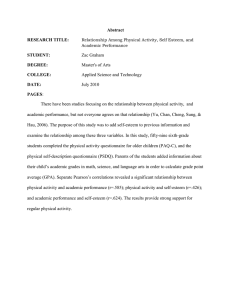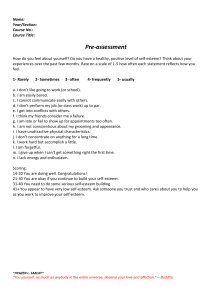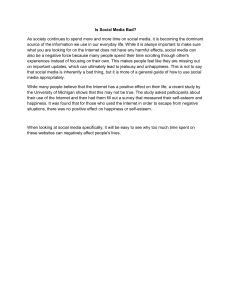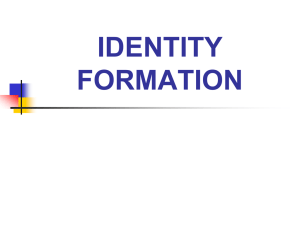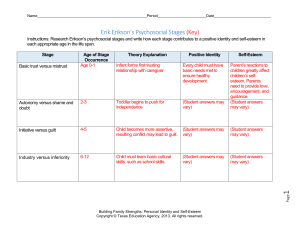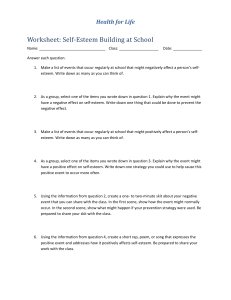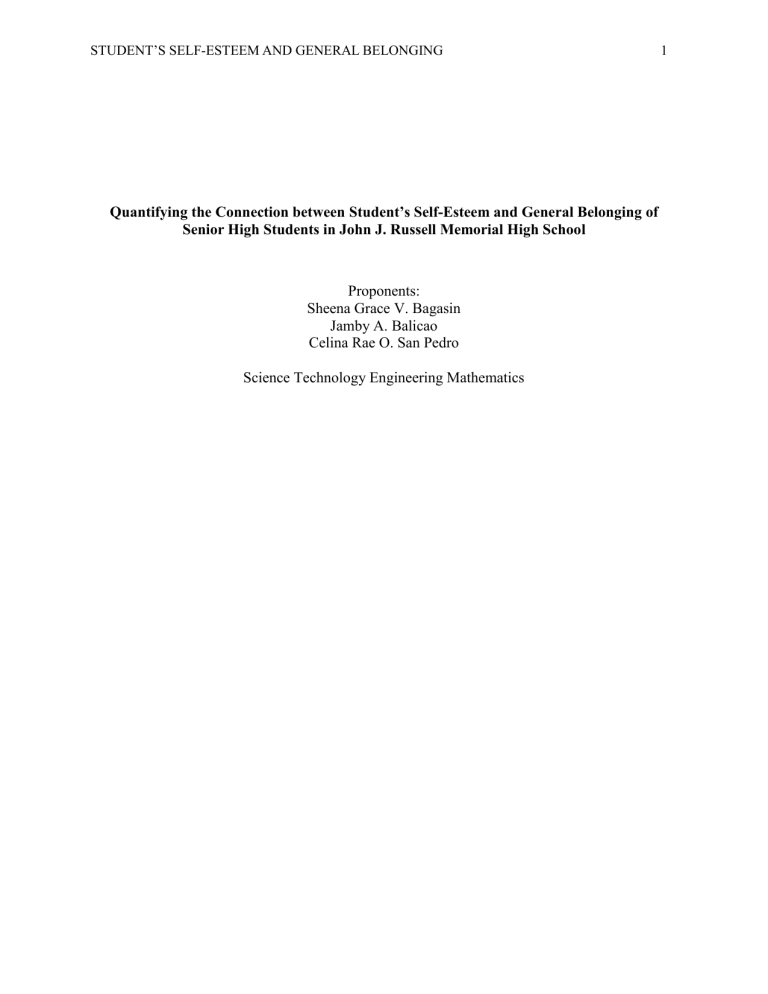
STUDENT’S SELF-ESTEEM AND GENERAL BELONGING Quantifying the Connection between Student’s Self-Esteem and General Belonging of Senior High Students in John J. Russell Memorial High School Proponents: Sheena Grace V. Bagasin Jamby A. Balicao Celina Rae O. San Pedro Science Technology Engineering Mathematics 1 STUDENT’S SELF-ESTEEM AND GENERAL BELONGING 2 Table of Contents Title Page 1 Table of Contents 2 List of Appendices 3 Acknowledgement 5 Biographical Sketch 6 Abstract 9 Introduction 10 Review of Related Literature and Studies 12 Conceptual Framework 14 Research Questions 15 Hypothesis 16 Significance of the Study 16 Scope and Limitations 16 Methodology 17 Type of Research 17 Respondents 17 Sampling Method 18 Sources of Data 18 Instrument/s 19 JOHN J. RUSSELL MEMORIAL HIGH SCHOOL STUDENT’S SELF-ESTEEM AND GENERAL BELONGING 3 Data Collection Procedure 19 Ethical Considerations 20 Data Analysis 20 Results and Discussion 21 Descriptive analysis of demographic profile of the students 21 Descriptive analysis of Student Academic Self-esteeem 22 Descriptive analysis of General Belongingness of students 25 Correlational analysis between Student academic Self-Esteem and General Belongingness 26 Summary of Findings, Conclusion, and Recommendation 27 Findings 27 Conclusions 27 Recommendations 28 References 30 Appendices 32 Learning Styles Questionnaire 33 Timetable/Gantt Chart 36 Approved Letter of Endorsement 38 Approve Letter of Consent 39 Approved Letter of Outline 40 Approved English Critique Certification 41 Absence of Conflict of Interest 42 Declaration of Anti-plagiarism 43 JOHN J. RUSSELL MEMORIAL HIGH SCHOOL STUDENT’S SELF-ESTEEM AND GENERAL BELONGING Curriculum Vitae 4 44 List of Tables Table Title Page 1 Population of respondents 18 2 Demographic Profile: Sex 21 3 Demographic Profile: Grade Level 21 4 Student Academic Self-esteem 22 5 General Belongingness 23 6 Correlation of Student Academic self-esteem and General Belongingness 26 List of Figures Figure 1 Title Conceptual Framework of the Study JOHN J. RUSSELL MEMORIAL HIGH SCHOOL Page 14 STUDENT’S SELF-ESTEEM AND GENERAL BELONGING 5 Acknowledgement For their invaluable contributions to the completion of this research project titled "Quantifying the Connection between Student’s Self-Esteem and General Belonging of Senior High School students in John J. Russell Memorial High School," the researchers would like to sincerely thank and appreciate the following people: First and foremost, the researchers want to express their heartfelt gratitude to Mrs. Sherry Ann Abugao. Rivera, their respected Research and English Critique Adviser. Her advice, expertise, and unwavering support throughout the research process were instrumental in shaping the direction and quality of this study. Her insightful suggestions and constructive criticism were extremely helpful in improving the research methodology and outlining the final manuscript. Additionally, the researchers would like to express their sincere gratitude to Dr. Bryan D.C. Gabriel. He provided the researchers with invaluable guidance and insights into the complexities of the research process thanks to his broad knowledge and expertise in the field of research. The researchers have consistently been inspired by his dedication and commitment to the pursuit of knowledge. The researchers would also like to thank the distinguished panelists, Mr. Limuel Hernandez, and Mrs. Sherry Ann A. Rivera. Their insightful feedback and critical assessment of the research proposal and final manuscript greatly improved the study's quality and credibility. The researchers sincerely appreciate their time, knowledge, and thoughtful contributions, which significantly improved the overall quality of this study. The researchers want to thank their friends and family for their unwavering support and encouragement. Their understanding, patience, and motivation provided the researchers with the foundation they needed to persevere during difficult times and to celebrate achievements. Finally, the researchers wanted to express JOHN J. RUSSELL MEMORIAL HIGH SCHOOL STUDENT’S SELF-ESTEEM AND GENERAL BELONGING 6 their sincere gratitude to their beloved God Almighty, whose blessings and divine guidance have served as a never-ending source of inspiration and courage throughout this research journey. Biographical Sketch Sheena Grace V. Bagasin, a Filipino female, is born on October 25, 2005, in San Miguel, Bulacan. She is currently 17 years old and single. Sheena is a Methodist and follows the religious beliefs associated with the denomination. She is the daughter of Irene V. Bagasin and Jackson I. Bagasin. During her elementary years, Sheena's achievements are not specified. However, it is evident that she transitioned to junior high school with exceptional academic performance. Throughout her junior high education, she consistently received honors for her outstanding academic achievements. She was awarded with honors from 2017 to 2022, showcasing her consistent dedication to academic excellence. Sheena is a graduating student from John J. Russell Memorial High School in Sibul Springs, San Miguel, Bulacan. Her pursuit of knowledge and commitment to her education have brought her to this milestone. As she approaches the end of her senior high school journey, Sheena looks forward to the next chapter of her academic and personal growth. With her track record of academic excellence and dedication, Sheena Grace V. Bagasin is a driven and accomplished student who consistently strives for success in her studies. As she continues her educational journey, she is poised to make a positive impact in her chosen field and contribute to society. JOHN J. RUSSELL MEMORIAL HIGH SCHOOL STUDENT’S SELF-ESTEEM AND GENERAL BELONGING 7 Biographical Sketch Jamby A. Balicao is born on October 01, 2004, in Bunot, Mt. Province. She is currently 18 years old and single. She is a devout Catholic and hails from a family with her mother, Jonalyn A. Balicao, and her father, Domenguez A. Balicao. In her elementary years, she showcased her exceptional talents and academic abilities. She received the Athlete of the Year award in 2017 and consistently achieved academic honors. Additionally, she was recognized for her outstanding skills in News Writing, earning an Achieving Award in 2017. During her junior high school education, Jamby continued to excel academically and athletically. She was awarded Athlete of the Year in both 2019 and 2020, highlighting her dedication and talent in sports. She also maintained her outstanding academic performance, earning honors in 2019, 2020, and 2021. In 2021, Jamby graduated with honors from Kalinga State University, showcasing her commitment to academic excellence. Currently, she is a senior high school student at John J. Russell Memorial High School in Sibul Springs, San Miguel, Bulacan. Throughout her educational journey, Jamby has consistently demonstrated her passion for sports, academic achievements, and commitment to personal growth. With her strong work ethic and determination, she is poised to achieve even greater accomplishments in the future. JOHN J. RUSSELL MEMORIAL HIGH SCHOOL STUDENT’S SELF-ESTEEM AND GENERAL BELONGING 8 Biographical Sketch Celina Rae O. San Pedro, a Filipino national, is born on January 4, 2005, at Manila Hospital in the city of Manila. She is currently 18 years old and single. Celina practices the Catholic faith and is a devout Catholic. Her mother's name is Celina G. Oserin, while her father's name is Reynaldo N. San Pedro. During her elementary years, Celina achieved the notable recognition of being named Athlete of the Year in 2017, showcasing her dedication and talent in sports. In her junior high school years, Celina continued to excel academically, earning the distinction of graduating with honors for five consecutive years, from 2017 to 2021. This consistent academic achievement reflects her strong work ethic and commitment to her studies. Currently, Celina is a senior high school student attending John J. Russell Memorial High School in Sibul Springs, San Miguel, Bulacan. She is expected to graduate from high school soon, marking another milestone in her educational journey. JOHN J. RUSSELL MEMORIAL HIGH SCHOOL STUDENT’S SELF-ESTEEM AND GENERAL BELONGING 9 Abstract Self-esteem can have a significant impact on an individual's life. They can lose many opportunities that will come to them. Self-esteem has a great contribution to students' academic performance, including their activities or even communication with their peers, teachers, and other folks. As the researchers observed, students with low self-esteem can have a poor sense of belonging, which can cause them to have poor academic performance. According to Maslow’s hierarchy of needs, esteem is one of the most essential needs for people in the world. A person's perceptions of their own value and worth are referred to as self-esteem. It also has to do with the emotions that people feel because of their perceptions of their value or unworthiness. Self-esteem is crucial since it has a big impact on people's decisions and choices. JOHN J. RUSSELL MEMORIAL HIGH SCHOOL STUDENT’S SELF-ESTEEM AND GENERAL BELONGING 10 Quantifying the Connection between Student’s Self-Esteem and General Belonging of Senior High Students in John J. Russell Memorial High School Introduction Self-esteem can have a significant impact on an individual's life. They can’t lose the many opportunities that will come to them. Self-esteem has a great contribution to students' academic performance, including their activities or even communication with their peers, teachers, and other folks. As the researchers observed, students with low self-esteem can have a poor sense of belonging, which can cause them to have poor academic performance. Most of the time, students feel embarrassed or have a hard time sharing their own knowledge, thoughts, and ideas. According to Maslow’s hierarchy of needs, esteem is one of the most essential needs for the people in the world. A person's perceptions of their own value and worth are referred to as self-esteem. It also has to do with the emotions that people feel because of their perceptions of their value or unworthiness. Self-esteem is crucial since it has a big impact on people's decisions and choices. Gordon Allport (2012) proposed that the growth of awareness of oneself proceeds along developmental and learning lines. He identified seven different aspects of selfhood. Self-esteem is the third developmental stage of the proprium. It is the feeling of pride that results when the child accomplishes things because of his or her success in mastering tasks. Coopersmith (2020) cited evidence supporting the importance of self-esteem. He concluded that people with feelings of inadequacy and unworthiness see themselves as inferior and are unable to generate inner resources to improve their situation. A feeling of inferiority may result if it does not meet personal aspirations. In his Antecedents of Self, he suggested four JOHN J. RUSSELL MEMORIAL HIGH SCHOOL STUDENT’S SELF-ESTEEM AND GENERAL BELONGING 11 factors that contribute to the development of self-esteem. These are: the values that the child perceives to have towards the self; the child’s experience with success and his individual definitions of success or failure; as well as the child’s style of dealing with negative feedback or criticism. The humanistic movement of 1950 and the self-movement postulated by Carl Rogers and others in the 1960s and 1970s brought in the self enhancement view of academics, seeing students' self-esteem as the primary cause of academic achievement. Wickline (2014), Bednar, and Peterson (2022) postulated that each person constructs his or her own unique view of reality. They further linked low self-esteem with drug abuse, anti-social behavior, teenage pregnancies, and poor grades. The researcher also aimed to investigate the relationship between self-esteem and qualities like competence, confidence, goal-directedness, and self-efficacy, as well as the impact these factors have on academic achievement. Additionally, the researcher was interested in learning how social issues like drug usage, subpar performance, and antisocial behavior relate to one's sense of self. Finally, the researcher wanted to know how the academic achievement of senior high school students at John J. Russell Memorial High School related to feelings of unworthiness, despair, doubt, personality maladjustment, and deviant behavior. JOHN J. RUSSELL MEMORIAL HIGH SCHOOL STUDENT’S SELF-ESTEEM AND GENERAL BELONGING 12 Review of Related Literature and Studies Self-Esteem For students, confidence is one of the reasons for their growth or development of personality and skills. Having a great and active personality can have a great effect on their academic performance. When someone has high self-esteem, it leads to great happiness, but when someone has low self-esteem, self-doubt will also be involved, which can potentially result in depression (Baumeister et al., 2012). According to (Sandra 2012), a person's self-esteem affects their thinking process, emotions, values, and goals. Self-esteem is the set of characteristics, qualities, deficiencies, capacities, and limitations that a person has, wherein the individual determines himself and his own characteristics (Marsh & Seeshing, 217). Looking at studies like other reports, individual self-esteem proves that it is associated with the academic performance of a learner (Castor, 2019). In addition, academic self-efficacy is how an individual knows their capability in performing the given task (Bong & Skaalvik, 2013). In fact, studies show that a student has high self-efficacy when they believe that they have the confidence to keep their learning activities in order and take difficult subjects easily (Bandura, 2020; Schunk, 2017; Zimmerman, 1013). According to the Self-esteem Theory of Rosenberg (2019), having knowledge can influence the learners’ psychological characteristics, such as self-esteem. Self-efficacy is an important topic in psychology because of the role it plays in actual behavior and because it is frequently discussed across a variety of fields and psychological sciences. The development of students' self-efficacy and the discovery of its influencing factors will have an impact on their academic achievement. The degree to which one believes they can complete activities and achieve their goals determines how strong their sense of self-efficacy is (Ormrod, 2015). JOHN J. RUSSELL MEMORIAL HIGH SCHOOL STUDENT’S SELF-ESTEEM AND GENERAL BELONGING 13 General Belonging Research emphasizes that the school plays a powerful role in the academic achievement of a student through a sense of belonging and promotes a good attitude through their education (Allen & Bowles, 2012; Ma, 2013). Furthermore, the study of Abbas Abdollahi and Amity Noltemeyer (2016) contained a variable that is a sense of self-belonging to school, which reveals the relationship between the sense of belonging and academic achievement is significant. A sense of belonging is defined with regards to what the students personally feel: being accepted, appreciated, respected, included, and safe in the school or the learner’s environment (Goodenow & Grady, 2013). Self-concept, self-esteem, and self-efficacy are important for students' behavior and academic achievement. This study aimed to determine the students’ academic achievements and self-concept, self-esteem, and self-efficacy. Results showed that self-concept, self-esteem, and self-efficacy did not significantly affect senior high school students’ academic performance (Jhoselle Tus, 2020). Teachers and parents should keep an eye on their kids and come up with additional programs to maximize the learning experience. JOHN J. RUSSELL MEMORIAL HIGH SCHOOL STUDENT’S SELF-ESTEEM AND GENERAL BELONGING 14 Conceptual Framework This conceptual framework highlights the significance of self-esteem and general belonging in relation to JJRMHS senior high school students. By quantifying and understanding these factors, educators, administrations, and policymakers can develop targeted inventions, programs, and support systems to foster positive self-esteem, promote a sense of belonging, and enhance overall student academic success. IV DV Student Academic SelfEsteem . General Belongingness Figure 1. Conceptual Framework of the Study The goal of this conceptual framework is to investigate the relationship between a student's self-esteem, general belonging, and academic success in the context of senior high school education at JJRMHS. Understanding the elements that contribute to the performance of senior high school students is essential for designing effective educational techniques and support systems. This paradigm tries to provide insights into how these qualities might be quantified and used to improve students’ outcomes by exploring the connection between academic self-esteem and general belonging. In the study of Ümmet (2015), where they studied the relationship between satisfaction and the psychological needs of the students, they found that the satisfaction and relatedness need JOHN J. RUSSELL MEMORIAL HIGH SCHOOL STUDENT’S SELF-ESTEEM AND GENERAL BELONGING 15 of the students significantly predicted their self-esteem. In addition, a high level of belonging relates to low levels of loneliness, low negative effects, high self-esteem, and high life satisfaction, as Duru (2015) stated. Self-esteem is an individual's overall evaluation and perception of their self-worth and capabilities. It can influence motivation, resilience, and academic engagement. Self-perception is how students perceive themselves academically, their strengths, and their weaknesses. Academic identity is how students identify in relation to their academic pursuits and achievements. General belonging is a student's sense of connection, acceptance, and integration within their educational environment. Belongingness is one of the basic needs that humans need to maintain their identity. It is important because it can have a positive effect on their self-esteem. It refers to a person's need to affiliate with others to be accepted by one circle of group to feel his or her acceptance. A sense of belonging is also the foundation for building one's personality, and it is related to self-esteem because they both need support from others. Research Questions Specifically, it aims to answer the following questions: 1. How may the profile affect the self-esteem of the students in terms of: 1.1 Sex 1.2 Grade Level 2. How may the self-esteem of the students be described? 3. How may the general belonging of the students be described? JOHN J. RUSSELL MEMORIAL HIGH SCHOOL STUDENT’S SELF-ESTEEM AND GENERAL BELONGING 4. 16 Is there a significant relationship between the students’ self-esteem and their general sense of belonging? Hypothesis This study will be guided and tested by the following hypothesis: 1. There is no significant relationship between the self-esteem and general belonging of the students at John J. Russell Memorial High School. Significance of the Study The researchers believe that this study will not only yield data that will be helpful to them, but more so to the following groups of people: Students. The students will be aware of the signs of low self-esteem. Once they know about it, they will help their co-students boost their self-esteem, especially themselves. Teachers. They are the students second parents. They can guide the students when they are at school. They will guide or help them and find ways for them to gain confidence. Parent/Guardian. They are the ones guiding their kids at home. They can do some practices and exercises for the kids to help them maintain and gain self-esteem. They can educate them about emotional intelligence. Future Researchers. This study can help them gather useful ideas to use for their future research studies involving sense of belongingness and self-esteem. Scope and Limitations This study aims to quantify the connection between students’ self-esteem and general belonging of senior high students in John J. Russell Memorial High School. JOHN J. RUSSELL MEMORIAL HIGH SCHOOL STUDENT’S SELF-ESTEEM AND GENERAL BELONGING 17 The assessment of this study will be conducted in the second semester of the school year 2022-2023. This study will utilize the descriptive quantitative and descriptive correlational research designs. The respondents of the study will be the senior high school students of John J. Russell Memorial High School, and they will be selected using stratified random sampling techniques with a 5% margin of error and a 95% confidence level. Also, this will be utilized using descriptive and inferential statistical treatments. Definition of Terms The following terms are further defined either operationally or conceptually: General Belonging. Feeling cherished in such a way that someone believes the organization values people for who they are. Quantifying. Describe or quantify the amount of. Self-Esteem. What we think of and value about ourselves. Methodology Type of Research This study will utilize the descriptive quantitative type of research, specifically descriptive evaluation, and descriptive correlational quantitative research. A descriptive evaluation will be used to describe the senior high school students’ demographic profile in terms of sex, their grade level, their self-esteem, and their general belonging. A descriptive, correlational, quantitative type of research will be utilized to determine the significant relationship between the students’ self-esteem and their general belonging. Respondents JOHN J. RUSSELL MEMORIAL HIGH SCHOOL STUDENT’S SELF-ESTEEM AND GENERAL BELONGING 18 The respondents of this study will be the senior high school students of John J. Russell Memorial High School, located in Barangay Sibul Springs, Springs, San Miguel, Bulacan. Respondents are heterogeneous in terms of sex and grade level. Sampling Method The stratified random sampling technique will be used to select the research respondents. The senior high school students of John J. Russell Memorial High School are the chosen subjects of this study. The grade 11 population is composed of 479 students, while in grade 12 there are 415 students, so the total population of senior high will be 894 students. In selecting the respondents, the total population of senior high school students will be calculated based on the SS formula to get the appropriate sample sizes for each section per grade level. Grade and Strand GRADE 11 STEM ABM HUMMS A HUMMS B GAS A GAS B GAS C GAS D GRADE 12 STEM ABM HUMMS GAS A GAS B GAS C GAS D Population size 479 Sample Size 148 54 50 63 61 58 65 64 64 415 17 15 19 19 18 20 20 20 128 40 47 57 66 68 67 70 T=894 12 14 18 20 21 21 21 T=276 Table 1: Population of Respondents (using Slovin’s Formula) JOHN J. RUSSELL MEMORIAL HIGH SCHOOL STUDENT’S SELF-ESTEEM AND GENERAL BELONGING 19 Sources of Data The sources of data will come from the existing records, journals, and studies that are related to the students’ self-esteem and general belonging. Also, to gather the data that is needed for this study, the Student Academic Self-Esteem questionnaire by ** and the General Belonging Scale questionnaire by G. Malone and P. Pillow. Instrument/s The instruments used to collect data were questionnaires. To be more specific, the researchers used the Student Academic Self-Esteem and General Belonging Scale by G. Malone and D. Pillow. Students’ academic self-esteem is measured using a 10-type survey questionnaire, which provides the students level of self-esteem. It will be a Likert-scale type of questionnaire. In this survey form, the students will choose among the levels of scale provided in the study: 1 (never), 2 (rarely), 3 (sometimes), and 4 (always), depending on every statement in the surveytype questionnaire. Internal Cronbach alpha range of 0.87. The students’ general belonging scale is composed of a 12-item type of survey questionnaire that provides their sense of belongingness. It will be a Likert-scale type of questionnaire. In this survey form, students will choose among the levels of scale provided in the study: 1 (strongly disagree), 2 (disagree), 3 (neither), 4 (agree), and 5 (strongly agree). Internal Cronbach alpha ranges from 0.68 to 0.82. Data Collection Procedure A step-by-step procedure will be considered in the conduct of this study to determine the significant relationship between the students' self-esteem and their general belongingness. The researcher will submit a letter of request to the school principal to get the permission needed to conduct and disseminate the survey questionnaire to the study's respondents, which are the Senior High School students at John J. Russell Memorial High School, School Year 2022-2023. JOHN J. RUSSELL MEMORIAL HIGH SCHOOL STUDENT’S SELF-ESTEEM AND GENERAL BELONGING 20 The researchers will then distribute the questionnaire, and the respondents will be given enough time to answer all the questions. After retrieving the survey questionnaire, the results will be tallied and calculated based on the statistical treatment that will be used. Ethical Considerations Prior to the conduct of the study, the researcher will have to obtain permission from the school principal; once approved, the project will then be performed. Consent and Assent letters should also be obtained because, even though the study does not contain any sensitive information, the subjects will all be minors. When collecting consent for the study, the researcher will not force the participants to sign the informed consent form. Participation in the study will be voluntary, and the researcher will state in the permission form instructions that students will have the option of participating or not. Prior to the study's implementation, the participants will be informed of the study's purpose. Data Analysis After gathering the needed data, appropriate statistical tools will be used to interpret the findings of the study. Descriptive statistics such as frequency and percentage will be employed to describe the students’ demographic profile in terms of sex and grade level. The mean and standard deviation will be utilized to determine the level of self-esteem and general belongingness of students. Inferential statistics such as Pearson Correlation will be utilized to test the hypothesis. Also, to discover the significant relationship between the students' self-esteem and their general belonging. JOHN J. RUSSELL MEMORIAL HIGH SCHOOL STUDENT’S SELF-ESTEEM AND GENERAL BELONGING 21 RESULTS AND DISCUSSION The goal of this study is to determine the significant relationship between the students’ self-esteem and their general sense of belonging. The following outline presents the results of the analysis. 1. How may the demographic profile of student be described in terms of: Table 2 Demographic Profile: Sex Sex Frequency Percent Male 116 42 Female 160 58 Total 276 100 According to the data from Table 1, the result of the demographic profile of senior high school student shows that the percentage of male respondents is 42%, while the percentage of female respondents is 58%, for a total of 100%. Table 3 Demographic Profile: Grade Level Grade Level Frequency Percent Grade 11 148 53.6 Grade 12 128 46.4 Total 276 100 Table 2 shows that most respondents are in grade 11, with a percentage of 65.6 percent. 2. How may the self-esteem of the students be described? Table 4 JOHN J. RUSSELL MEMORIAL HIGH SCHOOL STUDENT’S SELF-ESTEEM AND GENERAL BELONGING 22 Student Academic Self-Esteem S M SD VD 1. Learning activities in school is fun. 3.24 .734 ST 2. I have strong academic capabilities. 2.87 .775 ST 3. I do academic preparation for examinations in advance. 2.74 .859 ST 4. I feel good when I am in a class learning. 3.19 .805 ST 5. I feel good about myself when I attain good academic grades. 3.29 .811 A 6. I enjoy spending many hours on academic homework. 2.80 .870 7. I try hard to solve an academic problem until I make it. 3.05 .771 ST 8. I would rather spend most of my time reading as opposed to other activities. 2.58 .807 ST 9. I voluntarily answer questions (without being called) in class. 2.70 .830 ST 10. In class, I choose a position which is most visible to the teacher. 2.61 .882 ST TOTAL AVERAGE: 2.907 ST ST Legend: Rating Scale Verbal Description 3.25 – 4.00 Always (A) 2.50 – 3.24 Sometimes (ST) 1.75 – 2.49 Slightly (SL) 1.00 – 1.74 Not at all (NA) Table 2 shows the descriptive analysis of the Students’ Academic Self-Esteem. As shown in the table, students’ responses on the frequency level of their satisfaction with their self-esteem have the highest and lowest mean responses. Accordingly, item number 5 obtained the highest JOHN J. RUSSELL MEMORIAL HIGH SCHOOL STUDENT’S SELF-ESTEEM AND GENERAL BELONGING 23 mean responses of 3.29 with the verbal interpretation of "Always", where the students "feel good about themselves when they attain good academic grades," while item number 10 attained the lowest mean responses of 2.61 with the verbal interpretation of "Sometimes", where the students "are in class, they choose a position that is most visible to the teacher." In accordance with the study of Addero Wilson Ogot, Chepchieng Micah, and Kariuki Mary (2020) where the correlation mean was 2.17, the standard deviation was 0.935. The result of the mean score shows that there was a moderate level of academic self-esteem due to a value of 2.17 in a range of 0-4. The values are greater than 1.5 but less than 2.5, where the mid-point range is 2.0. Among the students rating the various statements on academic self-esteem, it reveals that "the students felt good about themselves when they attained good academic grades," and the lowest and most poorly rated was "that students would rather spend most of their time reading as opposed to other activities. The results implied that the senior high school student-respondents have a "high" to "very high" level of satisfaction with their academic Self-Esteem at the senior high school level. 3. How may the general belongings of the students be described? Table 5 General Belonging S M SD VD 1. When I am with other people, I feel included 3.56 .987 A JOHN J. RUSSELL MEMORIAL HIGH SCHOOL STUDENT’S SELF-ESTEEM AND GENERAL BELONGING 24 2. I have close bonds with family and friends 3.90 .956 A 3. I feel accepted by others 3.57 .972 A 4. I have a sense of belonging 3.45 1.035 A 5. I have a place at the table with others 3.41 1.075 A 6. I feel connected with others 3.50 1.034 A 7. I feel like an outsider 3.17 1.187 N 8. I feel as if people do not care about me 2.96 1.198 N 9. Because I do not belong, I feel distant during the holiday season 2.95 1.091 N 10. I feel isolated from the rest of the world 3.15 1.136 N 11. When I am with other people, I feel like stranger 3.12 1.209 N 12. Friends and family do not involve me in their plans 3.41 1.252 A JOHN J. RUSSELL MEMORIAL HIGH SCHOOL STUDENT’S SELF-ESTEEM AND GENERAL BELONGING TOTAL AVERAGE 3.34 25 N Legend: Rating Scale Verbal Description 4.21 - 5.00 Strongly Agree 1.81 - 2.60 Disagree 3.41 - 4.20 Agree 1.00 - 1.80 Strongly Disagree 2.61 - 3.40 Neither According to Table 3, the descriptive analysis of the General feeling of belonging shows that, as shown in the table, students’ responses on the frequency level of their satisfaction with their general feeling of belonging have the highest and lowest mean responses. Accordingly, item number 2 obtained the highest mean responses of 3.90 with the verbal interpretation of "Agree", where the students "have close bonds with family and friends," while item number 9 attained the lowest mean responses of 2.95 with the verbal interpretation of "Neither", where the students "feel distant during the holiday season because they do not belong." In addition, other studies specifically measuring belongingness among Spanish adults (Irene Checa & Ursula Oberst. 2021) have found in their descriptive data that is translated from Spanish to English. The highest mean rated in the statements from the General Belongingness Scale is "They have close bonds with family and friends" with a 5.75 mean, and 4.23 with the lowest mean rated, "They have a sense of belonging". The results implied that the senior high school student-respondents have a "high" to "very high" level of agreement with the General Belonging at the senior high school level. Is there a significant relationship between the students’ self-esteem and their general sense of belonging? JOHN J. RUSSELL MEMORIAL HIGH SCHOOL STUDENT’S SELF-ESTEEM AND GENERAL BELONGING 26 Table 6 GENERAL BELONGING Pearson Significance (2- Correlation Value tailed) .276** .000 .276** .000 STUDENT ACADEMIC SELF-ESTEEM Interpretation Decision Highly Reject the Null Significant Hypothesis Highly Reject the Null Significant Hypothesis **. Correlation is significant at the 0.01 level (2-tailed). Table 4 presents the relationship between General Belongingness and Student Academic Self-Esteem. Accordingly, Pearson’s R-moment correlation is applied if general belonging and Student Academic Self-esteem significantly affect each other. After the analysis, it was found out that General Belonging does significantly influence Student Academic Self-Esteem (Pearson Correlation value =.284) and the p-value (.000) is less than the alpha value (0.005). Additionally, the analysis showed a significant correlation between General Belongingness and Student Academic Self-esteem; therefore, do not reject the null hypothesis. Accordingly, item number 2 obtained the highest mean responses of 3.90 with the verbal interpretation of "Agree", where the students "have close bonds with family and friends," while item number 9 attained the lowest mean responses of 2.95 with the verbal interpretation of "Neither", where the students "feel distant during the holiday season because they do not belong." JOHN J. RUSSELL MEMORIAL HIGH SCHOOL STUDENT’S SELF-ESTEEM AND GENERAL BELONGING 27 Summary of Findings, Conclusion, and Recommendation Findings This study aims to identify the connection between students’ self-esteem and general belonging of senior high students in John J. Russell Memorial High School. Accordingly, item number 5 obtained the highest mean responses of 3.29 with the verbal interpretation of "Always", where the students "feel good about themselves when they attain good academic grades," while item number 10 attained the lowest mean responses of 2.61 with the verbal interpretation of "Sometimes", where the students "are in class, they choose a position that is most visible to the teacher." Accordingly, item number 2 obtained the highest mean responses of 3.90 with the verbal interpretation of "Agree", where the students "have close bonds with family and friends," while item number 9 attained the lowest mean responses of 2.95 with the verbal interpretation of "Neither", where the students "feel distant during the holiday season because they do not belong." This study provides information about the connection between students’ self-esteem and their general sense of belonging. As can be seen, our null hypothesis is not true, which leads to the fact that there is a highly significant relationship between students’ academic self-esteem and their sense of belonging. Conclusions Based on the findings of the study, the following conclusions are drawn: 1. Positive correlations appeared on both variables, which are the students’ academic selfesteem and General belonging. JOHN J. RUSSELL MEMORIAL HIGH SCHOOL STUDENT’S SELF-ESTEEM AND GENERAL BELONGING 28 2. It is important to focus on students’ academic self-esteem and general belonging since there is a correlation between the two that can affect other variables that are in Maslow's hierarchy of needs, where self-esteem and general belonging are also located. By paying attention to this, students will be able to be more attentive, which will improve their academic achievement. Recommendation The following suggestions were made in light of the study's results and conclusions: Here are the following recommendations made by the researchers for students, teachers, and parents or guardians, and especially for future researchers: 1. For the students, they should work first on communicating with other people. Practicing how to socialize with people is the number one step to improving their selfesteem and feeling that they belong to the environment wherever they are. 2. For the teachers, they can help their students in the school if they notice that one of them is not socializing like the others do. They can be their guide in improving and growing themselves to be better. 3. Parents or guardians should always check on or monitor their children. They should be the ones to make their children feel that they are not alone and that they belong in their own house. 4. For future researchers, this study is highly recommended to them. This may serve as their reference material or guide for those who want to conduct the same study related to the self-esteem and belongingness of senior high school students. They may add other JOHN J. RUSSELL MEMORIAL HIGH SCHOOL STUDENT’S SELF-ESTEEM AND GENERAL BELONGING 29 relevant information that will help them improve their study of students’ self-esteem and belongingness. JOHN J. RUSSELL MEMORIAL HIGH SCHOOL STUDENT’S SELF-ESTEEM AND GENERAL BELONGING 30 References Allen, K., Kern, M., Rozek, C., Mclnerney, D., Slavich, G. (2021) Belonging: a review of conceptual issues, an integrative framework, and directions for future research, Australian Journal of Psychology, 73:1, 87-102, DOI: 10.1080/00049530.2021.1883409 Checa, I., & Oberst, U. (2021). undefined. Current Psychology, 41(12), 8490-8498. doi:10.1007/s12144-020-01279-x Ghazvini, S. D. (2011). Relationships between academic self-concept and academic performance in high school students. Procedia - Social and Behavioral Sciences, 15, 1034-1039. doi:10.1016/j.sbspro.2011.03.235 Halse, C. (2018). Theories and Theorising of Belonging. In: Halse, C. (eds) Interrogating Belonging for Young People in Schools. Palgrave Macmillan, Cham. doi: 10.1007/978-3319-75217-4_1 Influence of self-esteem on students’ academic performance in secondary schools in Tharaka Nithi County, Kenya. (2019). Journal of Education and Practice. doi:10.7176/jep/10-218 Ogot, A. W., Chepchieng, M., Kariuki, M. (2020) Students’ Academic Self-Esteem and Academic Achievement Relationships in Public Secondary Schools in Nakuru County, Kenya. Journal of Education and Practice. Vol.11, No.24, 2020, doi: 10.7176/JEP/11-2418 Rosli, Y., Othman, H., Ishak, I., Lubis, S. H., Saat, N. Z., & Omar, B. (2012). Self-esteem and academic performance relationship amongst the second year undergraduate students of Universiti Kebangsaan Malaysia, Kuala Lumpur campus. Procedia - Social and Behavioral Sciences, 60, 582-589. doi:10.1016/j.sbspro.2012.09.426 Sarigoz, O. (2012). Assessment of the High School Students' Critical Thinking Skills. Procedia - Social and Behavioral Sciences, 46, 5315-5319. doi:10.1016/j.sbspro.2012.06.430 JOHN J. RUSSELL MEMORIAL HIGH SCHOOL STUDENT’S SELF-ESTEEM AND GENERAL BELONGING 31 Students’ academic self-esteem and academic achievement relationships in public secondary schools in Nakuru County, Kenya. (2020). Journal of Education and Practice. doi:10.7176/jep/11-24-18 Strudwicke, L. (2000). Sense of Belonging and Self-Esteem : What are the Implications for Educational Outcomes of Secondary School Students? : A Literature Review. https://ro.ecu.edu.au/theses_hons/867 Syeda Shahida Batool, Sumaira Khursheed, & Hira Jahangir (2017). Academic procrastination as a product of low self-esteem: A mediational role of academic self-efficacy. Pakistan Journal of Psychological Research, 2017, Vol. 32, No. 1, 195-211. Wang, C. W., & Neihart, M. (2015). Academic self-concept and academic self-efficacy: Selfbeliefs enable academic achievement of twice-exceptional students. Roeper Review, 37(2), 63-73. doi:10.1080/02783193.2015.1008660 Wang, Y., & Wang, L. (2016). Self-construal and creativity: The moderator effect of self-esteem. Personality and Individual Differences, 99, 184-189. doi:10.1016/j.paid.2016.04.086 Zeigler-Hill, V., & Shackelford, T. K. (Eds.). (2020). Encyclopedia of Personality and Individual Differences. doi:10.1007/978-3-319-24612-3 JOHN J. RUSSELL MEMORIAL HIGH SCHOOL STUDENT’S SELF-ESTEEM AND GENERAL BELONGING APPENDICES JOHN J. RUSSELL MEMORIAL HIGH SCHOOL 32 STUDENT’S SELF-ESTEEM AND GENERAL BELONGING 33 Appendix A Student Academic Self-Esteem Name: Grade & Section: Strand: 1. Indicate your sex with a tick (/ ) ( ) Male ( ) Female 2. Indicate with a tick (/ ) your age in years ( ) 16 years and below ( ) 17 years ( ) 18 years and above Instructions: Kindly put a tick ( / ) whether you do the statements (1) never, (2) rarely, (3) sometimes, (4) always. Statements 1. Learning activities in school is fun. 2. I have strong academic capabilities. 3. I do academic preparation for examinations in advance. 4. I feel good when I am in a class learning. 5. I feel good about myself when I attain good academic grades. 6. I enjoy spending many hours on academic homework. 7. I try hard to solve an academic problem until I make it. 8. I would rather spend most of my time reading as opposed to other activities. 9. I voluntarily answer questions (without being called) in class. 10. In class, I choose a position which is most visible to the teacher. JOHN J. RUSSELL MEMORIAL HIGH SCHOOL N R S A STUDENT’S SELF-ESTEEM AND GENERAL BELONGING 34 Appendix B General Belonging Scale Instructions: Below is a list of statements dealing with your sense of belonging about yourself. Check (/) If you (5) Strongly agree, (4) Agree, (3) Neither (2) Disagree, (1) Strongly disagree. 5 Statements 4 1. When I am with other people, I feel included 2. I have close bonds with family and friends 3. I feel accepted by others 4. I have a sense of belonging 5. I have a place at the table with others 6. I feel connected with others 7. I feel like an outsider 8. I feel as if people do not care about me 9. Because I do not belong, I feel distant during the holiday season JOHN J. RUSSELL MEMORIAL HIGH SCHOOL 3 2 1 STUDENT’S SELF-ESTEEM AND GENERAL BELONGING 10. I feel isolated from the rest of the world 11. When I am with other people, I feel like stranger 12. Friends and family do not involve me in their plans JOHN J. RUSSELL MEMORIAL HIGH SCHOOL 35 STUDENT’S SELF-ESTEEM AND GENERAL BELONGING 36 Timetable/Gantt Chart Objective Research Target Date/Time Activity Person Expected Involved Outcome Frame To provide research topics for the student’s academic performances Research title proposal February 15, 2023 Researchers Approve one topic in 3 proposed research topics To secure the target schedule for research defense proposal Research defense proposal February 2728, 2023 Researchers and the panel Secured the specific time and date for the research defense To orient student participant on the conduct of the study Conducting orientation to the student participants 1st week of March, 2023,vb \ Researcher and studentparticipants Well informed student participants on how the study will be conducted To distribute the research questionnaire to the student respondents Distribution of research questionnaires 1st week of March, 2023 Researcher and studentparticipants Answered survey questionnaires To retrieve the survey questionnaires Retrieval of survey questionnaires 1st week of March, Researcher and studentparticipants Gathered data 2023 To interpret the result of data gathered Interpretation of data gathered 1st week of April-2023 Researchers JOHN J. RUSSELL MEMORIAL HIGH SCHOOL STUDENT’S SELF-ESTEEM AND GENERAL BELONGING To present the whole research study. Final research defense To pass the final revised manuscript of research study. Deadline of Final manuscript 37 2nd weekLast week of April Researchers May 1-5, 2023 Researchers JOHN J. RUSSELL MEMORIAL HIGH SCHOOL Research defended STUDENT’S SELF-ESTEEM AND GENERAL BELONGING JOHN J. RUSSELL MEMORIAL HIGH SCHOOL 38 STUDENT’S SELF-ESTEEM AND GENERAL BELONGING JOHN J. RUSSELL MEMORIAL HIGH SCHOOL 39 STUDENT’S SELF-ESTEEM AND GENERAL BELONGING JOHN J. RUSSELL MEMORIAL HIGH SCHOOL 40 STUDENT’S SELF-ESTEEM AND GENERAL BELONGING Appendix D JOHN J. RUSSELL MEMORIAL HIGH SCHOOL 41 STUDENT’S SELF-ESTEEM AND GENERAL BELONGING 42 Appendix E DECLARATION OF ABSENCE OF CONFLICT INTEREST 1. We, Sheena Grace V. Bagasin, Jamby A. Balicao, and Celina Rae O. San Pedro, understand that conflict of interest refers to situations in which financial or other personal considerations may compromise my judgment in evaluating, conducting, or reporting research. 2. We hereby declare that I do not have any personal conflict of interest that may arise from the application and submission of my research proposal. We understand that my research proposal may be returned to me if found out that there is a conflict of interest during the initial is screening as per Research Management Guidelines (DepEd Order No. 16 s. 2017). 3. Further, in case of any form of conflict of interest (possible or actual) which may inadvertently emerge during the conduct of my research, I will duly report it to the research committee for immediate action. 4. I understand that I may be held accountable by the Department of Education and Policy Research Program (PRP) Fund (formerly Basic education Research Fund) for any conflict of interest which I have intentionally concealed. PROPONENT: ___________________ _____ PRINTED NAME: ________________________ SIGNATURE: ___________________________ DATE: ___________________________________ JOHN J. RUSSELL MEMORIAL HIGH SCHOOL STUDENT’S SELF-ESTEEM AND GENERAL BELONGING 43 Appendix F Enclosure No. 2 to Regional Memorandum No. 57 s. 2018 DECLARATION OF ANTI-PLAGIARISM 1. We, Sheena Grace V. Bagasin, Jamby A. Balicao, and Celina Rae O. San Pedro, understand that plagiarism is the act of taking and using another’s ideas and works and passing them off as one’s own. This includes explicitly copying the whole work of another person and/or using some parts of their work without proper acknowledgment and referencing. 2. We hereby attest to the originality of this research proposal and have cited properly all the references used. I further commit that all deliverables and the final research study emanating from this proposal shall be of original content. I shall use appropriate citations in referencing other works from various sources. 3. We understand that violation of this declaration and commitment shall be subject to consequences and shall be dealt with accordingly by the Department of Education and Policy Research Program (PRP) Fund (formerly Basic Education Research Fund). PROPONENT: ____________________ _____ PRINTED NAME: ________________________ SIGNATURE: ___________________________ DATE: ___________________________________ JOHN J. RUSSELL MEMORIAL HIGH SCHOOL STUDENT’S SELF-ESTEEM AND GENERAL BELONGING Appendix G JOHN J. RUSSELL MEMORIAL HIGH SCHOOL 44 STUDENT’S SELF-ESTEEM AND GENERAL BELONGING CURRICULUM VITAE JOHN J. RUSSELL MEMORIAL HIGH SCHOOL 45 STUDENT’S SELF-ESTEEM AND GENERAL BELONGING JOHN J. RUSSELL MEMORIAL HIGH SCHOOL 46 STUDENT’S SELF-ESTEEM AND GENERAL BELONGING JOHN J. RUSSELL MEMORIAL HIGH SCHOOL 47

